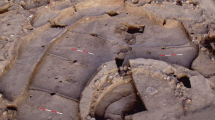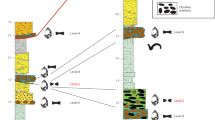Abstract
A recent computer-aided-design investigation of the Neolithic 56 Aubrey Hole circuit at Stonehenge has led to the discovery of an astonishingly simple geometrical construction for drawing an approximately regular 56-sided polygon, feasible with a compass and straightedge. In the present work, we prove analytically that the aforementioned construction yields as a byproduct, an extremely accurate method for approximating a regular heptagon, and we quantify the accuracy that prehistoric surveyors may have ideally attained using simple pegs and ropes. We compare this method with previous approximations, and argue that it is likely to be at the same time the simplest and most accurate. Implications of our findings are discussed.
Similar content being viewed by others
Article PDF
Author information
Authors and Affiliations
Corresponding authors
Rights and permissions
About this article
Cite this article
Johnson, A., Pimpinelli, A. Pegs and Ropes: Geometry at Stonehenge. Nat Prec (2008). https://doi.org/10.1038/npre.2008.2153.1
Received:
Accepted:
Published:
DOI: https://doi.org/10.1038/npre.2008.2153.1



